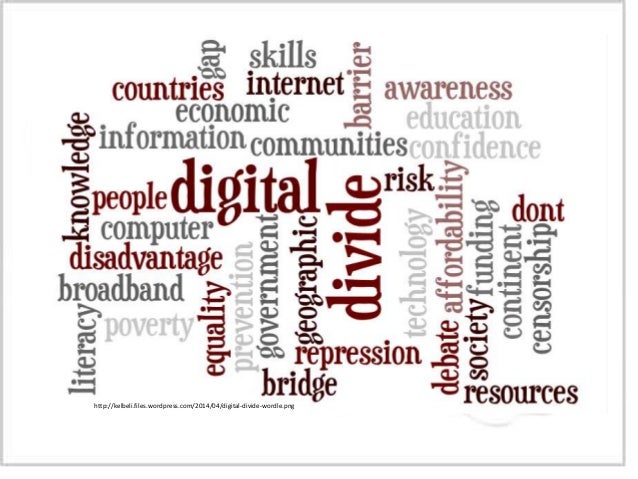My Part and Personal Vision
about the ff.
- Digital divide
- Addiction
- Bullying
- Ethical use Media and Information
- List down opportunities and challenges of Media and Information

Digital divide is a term that refers to the gap between demographics and regions that have access to modern information and communications technology, and those that don't or have restricted access. This technology can include the telephone, television, personal computers and the Internet.
The digital divide typically exists between those in cities and those in rural areas; between the educated and the uneducated; between socioeconomic groups; and, globally, between the more and less industrially developed nations. Even among populations with some access to technology, the digital divide can be evident in the form of lower-performance computers, lower-speed wireless connections, lower-priced connections such as dial-up, and limited access to subscription-based content.
The reality of a separate-access marketplace is problematic because of the rise of services such as video on demand, video conferencing and virtual classrooms, which require access to high-speed, high-quality connections that those on the less-served side of the digital divide cannot access and/or afford.
http://whatis.techtarget.com/definition/digital-
Combat Addiction
Problematic Internet usage is currently leading to workplace reprimands and employee termination, and has also been used as a defence to criminal charges in the United States. This article discusses the concept of Internet addiction. There have been attempts to medicalise this putative behavioural addiction drawing from DSM-IVTR criteria for substance abuse and pathological gambling. The grounds for this position and its legal and clinical implications are outlined.
http://www.ingentaconnect.com/search/article?option1=tka&value1=ADDICTION&pageSize=10&index=3
Combat Bullying
An evaluation of the success of the evidence-based ConRed program, which addresses cyberbullying and other emerging problems linked with the use of the internet and seeks to promote a positive use of this new environment. The main aims of the ConRed program are a) to improve perceived control over information on the internet, b) to reduce the time dedicated to digital device usage, and c) to prevent and reduce cyberbullying. The impact of the program was evaluated with a quasi-experimental design with a sample of 893 students (595 experimental and 298 control). The results of the mixed repeated measures ANOVAs demonstrate that ConRed contributes to reducing cyberbullying and cyber-dependence, to adjusting the perception of information control, and to increasing the perception of safety at school.

https://www.google.com.ph/search?q=digital+divide+bullying&biw=1366&bih=657&
source=lnms&tbm=isch&sa=X&sqi=2&ved=0ahUKEwiFt_-l197OAhVBuZQKHXSLA_sQ_AUIBigB#imgrc=S4ki5N8OpJ0T_M%3A
Ethical use Media and Information

Digital media ethics deals with the distinct ethical problems, practices and norms of digital news media. Digital news media includes online journalism, blogging, digital photojournalism, citizen journalism and social media. It includes questions about how professional journalism should use this ‘new media’ to research and publish stories, as well as how to use text or images provided by citizens.
List down opportunities and challenges
of Media and Information

The key information processing building blocks for yesterday’s organizations were typewriters, carbon paper, filing cabinets, and a government mail service. The constraints of these crude information processing technologies often required workers to be located under one roof and organizations to arrange themselves as efficient, but relatively change-resistant, management hierarchies. Those legacy organization designs have persisted despite fundamental changes in information processing technology. Tomorrow’s successful organizations will be designed around the building blocks of advanced computer and communications technology. The success of these organizations will come from the ability to couple to, and decouple from, the networks of knowledge nodes. These networked organizations will link, on an asneeded basis, teams of empowered employees, consultants, suppliers, and customers. These ad hoc teams will solve one-time problems, provide personalized customer service, and then, as lubricant for subsequent interactions, evaluate one another’s performance. In the network organization, structure will dominate strategy, credentials will give way to performance and knowledge, and human resources will be the only sustainable advantage. Despite the promise, networked organizations present difficult information management challenges. Among these are developing a Hexible and efficient information architecture, establishing new values, attitudes, and behaviors concerning information sharing, building databases that can provide integrated customer support on a worldwide basis, and protecting personal freedoms and privacy. Here, we explore the opportunities and challenges that networked organizations will present for information technology management.
https://scholar.google.com.ph/scholar?q=+Media+and+Information+++images&btnG=&hl=en&as_sdt=0%2C5&as_vis=1
Posted by: Reynadith J. Achacoso
Grade XI Socrates
No comments:
Post a Comment